Sony Alpha SLT-A55 Review
Sony Alpha SLT-A55 Introduction
The Sony Alpha SLT-A55 is the flagship of a unique pair of ILCs that use a translucent mirror to provide full-time continuous autofocus during video recording and at very fast burst-rates. This unique design lets this camera use phase-detection autofocus, the same system used in all current DSLRs, while maintaining a Live-View display on its LCD or on its top-notch EVF.
In addition to an innovative design, the Alpha SLT-A55 incorporates many of Sony's class-leading technologies. This includes their latest generation CMOS sensor with 16 megapixels and the ability to record full 1080p HD videos. The continuous drive on the A55 can reach a burst-rate of 10 FPS at full resolution. This quick drive is used to support Multi-Frame ISO Capture to reduce image noise while reaching a maximum sensitivity of 25600 and to implement Sweep Panorama capture.
The A55 itself comes in two variants, the A55V which includes a built-in GPS and the vanilla A55. Their smaller sibling is the Sony Alpha SLT-A33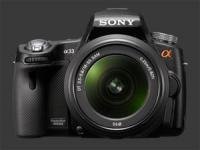
Sony Alpha SLT-A33 which uses a very similar 14 megapixels sensor instead and achieves a maximum burst-rate of 7 FPS. The GPS on the A55V records position, elevation and orientation data directly in the EXIF of its images.
This detailed digital camera review takes a close look at the Sony Alpha SLT-A55 in terms of features, ergonomics, usability, performance, image quality and its unique capabilities. As the flagship SLT camera, the A55 boasts the following features:
- 16 Megapixels image sensor, 1.5X crop-factor.
- Sony Alpha lens mount, compatible with Konica-Minolta AF lenses.
- Built-in image stabilization, for all lenses at no additional cost.
- Automatic and selectable ISO from 100 to 12800.
- Automatic and selectable Multi-Frame ISO from 100 to 25600.
- 1/4000s to 30s shutter-speeds, plus bulb mode.
- Exposure-Compensation, -2..+2 EV, in 1/3 EV increments.
- Automatic, preset, Kelvin and custom white-balance.
- While-balance fine-tuning, along 1 axis in 19 steps, except for AWB.
- 15-point autofocus system, including 3 cross-type points.
- Focus-point selection: automatic, manual or center.
- Focus modes: Single-shot (AF-S), continuous (AF-C), automatic (AF-A), and manual (MF).
- Metering modes: Multi-segment, center-weighed and spot.
- Full manual controls, including PASM modes.
- Exposure bracketing, 3 images, 1/3 or 2/3 EV increments.
- White-balance bracketing, 3 images, 2 step-sizes.
- Customizable contrast, saturation and sharpness, 7 steps each.
- 2s and 10s self-timers, plus wired remote trigger.
- Auto-Exposure-Lock (AEL), Auto-Focus-Lock (AFL)
- Image review with magnification and separate R, G, B & L histograms.
- Depth-of-field preview.
- JPEG, RAW and JPEG+RAW modes.
- Built-in popup flash and Minolta-type hot-shoe.
- Powered by an Info-Lithium battery.
- Secure Digital Extended Capacity & Memory Stick Pro support.
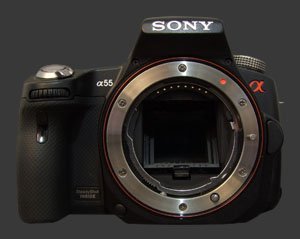
The Sony Alpha SLT-A55V also stands-out by having the following features, many of them unique to the Sony Alpha SLT-family:
- Built-in dust-reduction and manual mirror release.
- Automatic and adjustable dynamic range, 5 levels.
- Automatic and selectable HDR capture, up to 6 EV spread.
- 10 FPS Continuous drive Aperture-priority mode using AF-S.
- 10 FPS Continuous drive at widest aperture using AF-C.
- 7 FPS Continuous drive with no restrictions.
- Dual-axis digital level HUD.
- Manual-Focus assist magnification.
- True Live-View EVF & LCD display.
- 100% Coverage on both EVF & LCD.
- 0.46" EVF with 1.4 Megapixels.
- 3" Rotating LCD with 921K pixels and 16:9 aspect.
- Eye-Start sensor, automatically selects between EVF & LCD.
- Optional Eye-Start AF to speed up focusing.
- Video recording with continuous AF and AE.
- Full 1920x1080 @ 30 FPS video capture using AVCHD codec.
- Anamorphic 1440x1080 @ 30 FPS video capture using MPEG-4 codec.
- Built-in stereo microphone.
- Mini-jack connector for external stereo audio input.
- Built-in GPS with position, elevation and orientation data (A55V only).
For an editorial view of what SLT technology is and what it implies for digital cameras, see this blog post. Note that SLT technology is put in context further in this review, so reading the blog post is entirely optional.
Sony Alpha SLT-A55 Suitability - What is it good for?
The Alpha SLT-A55 may not be a DSLR, but for suitability purposes it is nearly equivalent. Since it is an ILC, this camera affords the versatility which gives SLR cameras their greatest potential. In all likelihood, the A55 shares its sensor with current flagship cropped-sensor DSLRs from Nikon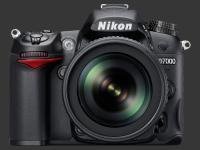
Nikon D7000, Pentax
Pentax K-5 and Sony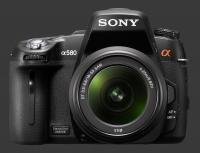
Sony Alpha A580. Image quality from such a camera is expected to differ by 1/3 stops in terms of image noise compared to modern DSLRs. The reason is that the translucent mirror diverts 30% of light towards the phase-detect AF sensor, so the image sensor has to work with less light to achieve the same sensitivity as a conventional DSLR.
This SLT model is among the fastest large-sensor cameras. The 5X times more expensive Canon EOS 1D Mark IV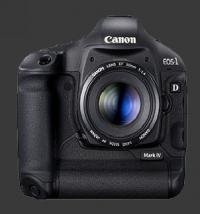
Canon EOS 1D Mark IV can also reach 10 FPS while shooting continuously and it is not capable of true continuous autofocusInstead cameras like this one use Predictive AF since they do not have time to completely focus between shots at 10 FPS while doing so. Granted that the A55 also has some catches at 10 FPS but it remains ahead of the class for its price. The continuous buffer is also deep enough to capture 28 JPEG images. Just like all DSLR cameras, this Sony uses phase-detect autofocus which is known to be quicker than the contrast-detect system used by most other types of digital cameras.
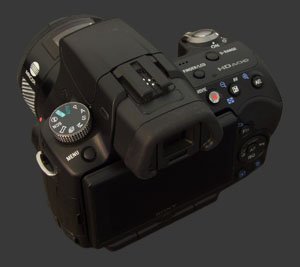 This says that the Sony SLT-A55 is similarly suitable for all types of photographic subjects as the majority of DSLR cameras. While there are minor differences which will be explained in the Usability page of this review, the most important consideration is the availability of lenses. Sony's lens lineup is relatively small but several third party lenses exist for the Sony Alpha mount. As usual, it is therefore advisable to check available lenses to make sure they cover any specific photographic needs you may have. Remember though that the Sony line-up does not need any stabilized lenses since stabilization is provided by the body for all lenses.
This says that the Sony SLT-A55 is similarly suitable for all types of photographic subjects as the majority of DSLR cameras. While there are minor differences which will be explained in the Usability page of this review, the most important consideration is the availability of lenses. Sony's lens lineup is relatively small but several third party lenses exist for the Sony Alpha mount. As usual, it is therefore advisable to check available lenses to make sure they cover any specific photographic needs you may have. Remember though that the Sony line-up does not need any stabilized lenses since stabilization is provided by the body for all lenses.
Although this camera is designed as an entry-level offering with its light body, single control-dial and beginner-oriented feature-set, it has characteristics normally found on higher-end DSLRs:
- The most important is a 100% coverage viewfinder which is available on many cameras but commands a premium among DSLRs.
- A dual-axis digital level which is implemented on very few cameras so far.
- 7 FPS Continuous drive mode and restricted 10 FPS drive.
- Full 1080p HD video recording with stereo microphone and mini-jack.
Obviously, for its excellent price-point, the A55 does not offer weather-resistance or much in terms of controls beyond the basics for manual controls. Instead it packs more automation features such as Sweep Panorama, Automatic HDR, Automatic Dynamic Range Optimization and Scene Mode auto-detection.
What the Sony Alpha SLT-A55 adds to this DSLR-like suitability is a compact form-factor and phase-detect autofocus during video recording. Its diminutive size is very close to the smallest DSLR which uses a Four-Thirds sensor with 2X crop-factor. It is still somewhat bigger than Micro Four-Thirds and NEX cameras which forgo a built-in viewfinder and often a grip to achieve true compactness among cameras with interchangeable lenses.
Sony Alpha SLT-A55 Capability - What can it do?
Headline features of Sony Alpha SLT-A55 include its 16 megapixels CMOS sensor with a standard sensitivity range from 100 to 12800. This is suitable for large prints up to 24" x 16" until high ISO sensitivities where noise starts eating details. There is also an expanded sensitivity range from 100-25600 using Multi-Frame ISO noise-reduction. The camera continuously captures up to five frames which are blended together to reduce noise. It only works for JPEG images of still subjects. It is ideal to do this from a tripod using the optional wired remote, particularly since the A55 does not allow a self-timer to be activated for Multi-Frame ISO. A special sample page comparing standard and Multi-Frame ISO is included in this review.
The CMOS sensor can output full 1080p HD video at 30 FPS. The A55 encodes this using the AVCHD into a file which appears to be 1080i with sequential fields forming a progressive frame. If that sounds complicated, no worries, the point is that 1080p HD video is captured but some applications may report it as 1080i due to the unusual encoding. There is an option to use MPEG-4 at an anamorphic resolution of 1440x1080 @ 30 FPS. This is still shown as 16:9 wide-screen video since anamorphic means the pixels are rectangular instead of square.
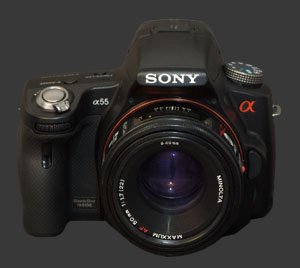
The outstanding feature of the SLT-A55 is its 10 FPS continuous drive. This is done with a mechanical shutter and either single-shot (AF-S) or continuous (AF-C) autofocus. In AF-S mode, the camera essentially enters Aperture-priority exposure mode. In AF-C mode, the camera keeps the aperture wide-open and locks the ISO on automatic. The reason this makes sense is that the time between each shot is too short for the camera to lock focus and so it must focus during each shot. This is only doable because the SLT-A55 uses a translucent mirror but phase-detection autofocus is always done wide-open and so it must keep the aperture fixed during shots. When reducing the burst speed to 7 FPS, the camera can attempt to focus continuously between shots, stopping-down the aperture at each frame.
The fast mechanical shutter is also used in Sweep Panorama mode which produces a single-row panorama directly in-camera by blending parts of up to 25 frames. The result is a moderately low-resolution panorama spanning a extremely wide-angle. There are two options for the angle and the panorama can be taken in any direction, with the camera stopping when a large-enough arc has been swept. The A55 can produce a 3D Panorama instead by cleverly creating a stereoscopic image out of stitched frame slices. The angle-of-view of panoramas depends on the lens used. Sony suggests using a wide-angle lens is better. It is quite easy to use this mode and have it produce something. Stitching is a complex operation though, so multiple tries are often required. Moving subjects make it nearly impossible perform a correct panorama. Finally, it is difficult to predict how a Sweep Panorama will be framed since the camera removes pixels from edges to produce a rectangular image.
 A built-in mechanism, called Super Steady Shot and derived from Konica-Minolta's ground-breaking Anti-Shake system, provides image stabilization for all lenses at no additional cost. This generally improves sharpness by 2-3 stops over normal hand-holding. This is not only a cost-saving feature as it also works for lenses which no stabilized counter-parts such as fast prime and fisheye lenses. Presumably this is used internally to line-up images during Multi-Frame ISO and HDR photography.
A built-in mechanism, called Super Steady Shot and derived from Konica-Minolta's ground-breaking Anti-Shake system, provides image stabilization for all lenses at no additional cost. This generally improves sharpness by 2-3 stops over normal hand-holding. This is not only a cost-saving feature as it also works for lenses which no stabilized counter-parts such as fast prime and fisheye lenses. Presumably this is used internally to line-up images during Multi-Frame ISO and HDR photography.
The Alpha SLT-A55 includes Sony's improved DRO system to control dynamic-range. When enabled, the DRO can extend apparent dynamic-range using a single image or capture increased dynamic range using exposure-blending. In single frame mode, shown as DRO in the interface, this digital camera simply changes the way it processes RAW sensor data to produce an image with lighter shadows. The strength of this process can be set to Auto or one of five levels. Generally speaking, this tends to reduce the contrast of images, it should be applied gently and only when needed. In multiple frame mode, shown as HDR in the interface, the A55 takes 3 consecutive shots and blends them together to form an HDR image. The bracketing spread of the captured images can be set to Auto or between 1 and 6 EVs, in full-stop increments.
Having both an LCD and an EVF allows the SLT-A55 to provide a perfect Live-View experience with complete consistency. The semi-transparent mirror lets autofocus and sensors to work equally with the EVF and LCD. The main advantage is that phase-detection autofocus is constantly available. The only catch is that autofocus sensors must work harder than on a DSLR since they receive less than one third of the light.
 As the Sony Alpha SLT-A55 falls into the SLD category of digital cameras, it relies on Live-View to preview images. The implementation here is truly excellent, providing an exposure-priority display with 100% coverage, accurate colors, white-balance and focus. These is also a DOF preview function to stop down the lens as needed. Not only that, it provides full-time phase-detect autofocus at the same speed regardless of which display is used. Due to limitations of LCD technology, dynamic-range changes cannot be previewed. Still, this is the best Live-View experience on any ILC so far. Kudos to Sony for that, which they will surely reap benefits as fixed-lens camera owners upgrade to SLT models.
As the Sony Alpha SLT-A55 falls into the SLD category of digital cameras, it relies on Live-View to preview images. The implementation here is truly excellent, providing an exposure-priority display with 100% coverage, accurate colors, white-balance and focus. These is also a DOF preview function to stop down the lens as needed. Not only that, it provides full-time phase-detect autofocus at the same speed regardless of which display is used. Due to limitations of LCD technology, dynamic-range changes cannot be previewed. Still, this is the best Live-View experience on any ILC so far. Kudos to Sony for that, which they will surely reap benefits as fixed-lens camera owners upgrade to SLT models.
This digital camera has the standard set of exposure modes, plus a few scene modes and three variations on automatic exposure. P mode is the standard automatic mode which relies on the photographer to control the rest of the camera. Auto is en extremely restricted version of Program mode. It locks ISO to Auto and EC to 0, as well as enabling automatic flash rather aggressively by default. At least, flash usage can be suppressed or forced in this mode. Auto+ automatically selects a scene mode depending on unspecified parameters. There are also 8 scene modes to choose from, all of them fully automatic.
The look of images from the A55 can be controlled be selecting a Creative Style. There are 6 of them: Standard, Vivid, Portrait, Landscape, Sunset and B&W. Each Creative Style establishes a baseline from which contrast, saturation and sharpness can be changed among 7 levels each. The key here is to know that image parameters are relative, so that +3 of sharpness in Standard style is less sharp than even +2 of sharpness in Landscape style. Saturation and Contrast behave the same way.
White-balance can set to Auto, one of 6 presets, a Kelvin color-temperature or a custom setting. Auto and Custom white-balance cannot be tweaked but presets can be modified in 7 steps along the Blue-Yellow axis and Kelvin white-balance can be modified in 18 steps along the Magenta-Green axis. The three metering modes are completely standard: Multi-Segment, Center-Weighed and Spot.
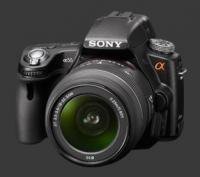 |
Please Support Neocamera
All information on Neocamera is provided free of charge yet running this website is a huge endeavor. Purchases made via affiliate links found throughout the site help keep it running and up-to-date. There is no additional cost to you, so please consider buying via these links to our affilates:
If you found any information on this site valuable and did not purchase via our affiliate links, please considering donating via PayPal:
Any amount will be greatly appreaciated. Thank you for your support!
Sony SLT-A55 Highlights

Sensor-Size: 24 x 16mm

Actual size when viewed at 100 DPI
| 16 Megapixels Mirrorless | ISO 100-25600 |
| Sony A Mount 1.5X FLM | Shutter 1/4000-30s |
| 2-Axis Built-in Stabilization | Full manual controls, including Manual Focus |
| 0.46" Built-in EVF 1.4 Megapixels (0.73X) | Custom white-balance with 1 axis fine-tuning |
| Automatic Eye-Start sensor | Spot-Metering |
| 2 Axis Digital Level | Hot-Shoe |
| Built-in Dust Reduction | Stereo audio input |
| 10 FPS Drive, 35 Images | Lithium-Ion Battery |
| 1920x1080 @ 30 FPS Video Recording | Secure Digital Extended Capacity, Memory Stick Duo |
| 3" LCD 920K Pixels |
Updates
2025.01.18

Fujifilm GFX 2025 Lens Roundup
Lens Review roundup of Fujifilm GFX Medium-Format lenses. Quality, performance and handling of the GF20-35mm F/4R WR, GF30mm F/3.5 Tilt-Shift and the GF55mm F/1.7.
2024.11.18

Best 2024 Photography Gifts for Every Budget
Great gifts for photographers and photo enthusiasts selected for every budget among the best products of 2024.
2024.08.07

Eye Protection Tips for Professional Photographers
The four main considerations for professional photographers regarding eyewear.
2024.07.14

Fujifilm X100VI Review
Flagship fixed-lens compact digital camera with a 40 MP sensor and Image-Stabilization, a first for the series. Retro design featuring dual control-dials, plus direct ISO, Shutter-Speed and EC dials. Its hybrid viewfinder can switch between EVF and OVF mode.
2024.05.09

Fujifilm GFX100 II Review
Flagship 102 Megapixels Medium-Format Mirrorless Digital Camera with 8-Stop 5-Axis IBIS, 8 FPS Drive, 8K Video and 400 MP Super-Resolution capture in a weatherproof and freezeproof body with dual control-dials and dual memory-card slots.
2024.04.03

Fujifilm X-T5 Review
Newest Fujifilm flagship boasting a 40 MP APS-C sensor, 5-axis IBIS with 7-stop efficiency, 15 FPS continuous drive, 6.2K Video capture, dual control-dials and dual SDXC UHS-II slots in a sturdy weatherproof and freezeproof body.
2023.11.20

Best Digital Cameras of 2023
Find out which are the Best Digital Cameras of 2023. All the new Mirrorless Digital Cameras from entry-level to high-end professional.
2023.07.10

Fujifilm X-H2 Review
40 Megapixels APS-C Hybrid Mirrorless Digital Camera with 7-stop IBIS. Fastest shutter ever and 8K video capture. Large builtin EVF with 0.8X magnification and 5.8 MP, plus an Eye-Start Sensor. Packed with features and large number of controls in a weatherproof and freezeproof body.
2023.05.07

Sony FE 20-70mm F/4G Review
Review of the unique Sony FE 20-70mm F/4G lens. The optical zoom of this lens spans ultra-wide-angle and medium focal-length coverage, making it one of the most versatile Full-Frame lenses on the market.
2023.01.15

Huion Inspiroy Dial 2 Review
Review of the Huion Inspiroy Dial 2 tablet, a medium sized drawing surface with dual dials and customizable buttons. Connects via USB-C or Bluetooth 5.0 with Windows, Linux and Android support.
2022.12.08

How to Pack for a Photo Trip
Find out how to pack for a travel photography trip, carry your gear safely while meeting airline regulations.
2022.11.13

Best Digital Cameras of 2022
The best digital cameras of 2022. A short list of the most outstanding models in their respective categories. Choose one for yourself or as a gift.














